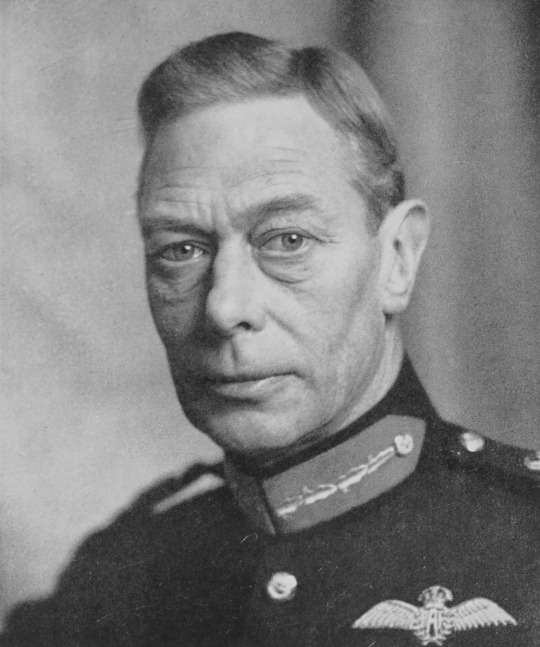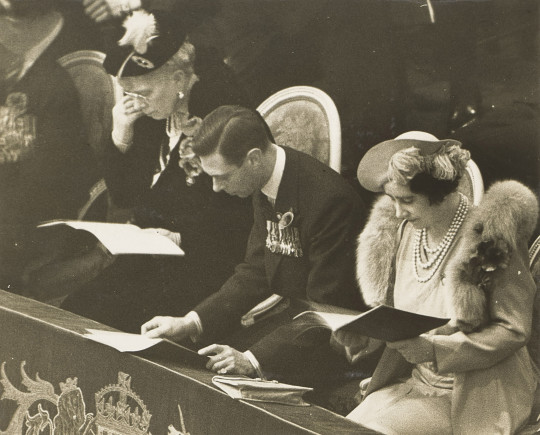Text


May 8, 1951: King Frederik IX and Queen Ingrid of Denmark are welcomed by King George VI and Queen Elizabeth at Victoria station at the start of their 4-day state visit to Britain. // British Pathé
16 notes
·
View notes
Text

King George VI visits Sherborne School in Dorset in recognition of its 400th anniversary. The King is pictured with the school’s headmaster, Alexander Ross Wallace. // June 1, 1950
23 notes
·
View notes
Text

King George VI and Queen Elizabeth visit volunteer agricultural workers in Berkshire, July 1944.
"The girls were wearing trousers rolled to the knee. ‘Nearly everyone seems to prefer trousers nowadays,’ said the King." // x
27 notes
·
View notes
Text
It will in no way detract, I am sure, from the prestige of my brother, the King, when I say that when we were young I could always manage him. That is, after all, the established prerogative of older brothers. Moreover, through long observation and experimentation, we knew exactly how to make each other angry.
The Duke of Windsor - A King’s Story (1951)
22 notes
·
View notes
Text
THE ROYAL FAMILY in Mafeking (now Mahikeng) South Africa, 1947 // IWM
The amateur footage shows them meeting local dignitaries at an outdoor event; they then meet veterans of both world wars before heading back to their cars. [no sound]
#King George VI#Queen Mother#Queen Elizabeth II#Princess Margaret#British Royal Family#SA47#1947#1940s#video
14 notes
·
View notes
Text


King George VI and Queen Elizabeth travel in a motorcade during their visit to New York. With them are New York Mayor Fiorello La Guardia and Governor Herbert H. Lehman // June 10, 1939
For reasons of safety and speed, the Royal procession bypassed Broadway and instead took a more ‘open’ route on the way to the World’s Fair in Flushing Meadows:
They seemed to know a great deal about the layout of the city, and they asked many questions about it. I don’t know whether it is just my own disappointment about not being able to take them up Fifth Avenue and Broadway, but I gathered that they would have preferred that route. As we drove up the West Side Highway both the King and Queen asked several times how far we were from Broadway, and how far from Fifth Avenue. They were very much interested in Broadway.
At one point in Queens there was a section that did not seem to be covered well, and a large crowd of people surged downhill to fill it up. One of our motorcycle policemen swung over to keep them in bounds, and the King remarked, as if voicing his thoughts:
‘Don’t worry - the crowd always takes care of itself.’
Fiorello La Guardia // quoted in Voyage of State by G. Gordon Young (1939)
14 notes
·
View notes
Text

KING GEORGE VI photographed by HORACE GILCHRIST, November 1951
22 notes
·
View notes
Text

The Prince of Wales gardening at Fort Belvedere with the help of his week-end guests, including the Duke of York, c.1930.
‘I was in such a hurry to make the place over that I begrudged as lost a daylight hour that did not see the work progressing. Saturday afternoons and Sundays, when my gardeners were off, I pressed my week-end guests into arduous physical labor to which some of them were unaccustomed. Groaning and grunting, they joined me in hacking out the underbrush, pruning trees, and transplanting shrubs; but presently they began to share my enthusiasm. Even my brother Bertie, who lived nearby in the Great Park at Royal Lodge, would drop over to lend a hand.’
The Duke of Windsor - A King’s Story (1951)
30 notes
·
View notes
Text


Self. Bertie. E.
Queen Mary, King George VI and Queen Elizabeth in the Royal Box during the British Legion Festival of Remembrance at the Royal Albert Hall, November 11, 1938. (From Queen Mary’s photo album) // RCT
16 notes
·
View notes
Text

THE KING UNVEILS THE WINDSOR MEMORIAL
The Royal Borough’s Tribute to the First Sovereign of the House of Windsor and its Site Beneath the Castle Walls // April 23, 1937
The scene after the unveiling by the King on St. George’s Day of the memorial to his father which has been designed by Sir Edwin Lutyens, R.A., erected on a site below the Castle walls presented by Lord Wakefield, and paid for by contributions from the inhabitants of the Royal Borough and of the city of Windsor, Ontario. The ceremony, which was attended by many members of the Royal Family including the Queen, Queen Mary, the Duke and Duchess of Gloucester, and Prince and Princess Arthur of Connaught, started with a short dedication service conducted by the Dean of Windsor and then followed an address from the Mayor in his capacity of Chairman of the Memorial Committee.
GEORGE V MEMORIAL // British Pathé
The King in the course of his reply said: ‘To me personally the memory of my father will always bring the inspiration of a high example. I hope that in trying to fulfil our great responsibilities the Queen and I may be supported by some measure of that trust and affection which were so fully given to him and to my dear mother by the peoples of this country and of the Empire.’
11 notes
·
View notes
Text

Princess Alexandra of Kent curtseys to her uncle, King George VI, at the Royal Windsor Horse Show, May 27, 1944. // British Pathé
38 notes
·
View notes
Text

King George VI’s speech, with alterations in his own hand, given at a dinner party for the Commonwealth Prime Ministers on 13 October 1948. // © Royal Archives
The events of the Second World War led to a subtle change in relations between the nations of the Empire: there was a much greater feeling of the countries being ‘equal but independent Nations’ than previously. During the war, meetings had been held in London of the Prime Ministers of the Dominions (Canada, Australia, New Zealand, South Africa - and Southern Rhodesia, which had traditionally held a sort of hybrid status between colony and Dominion) and the British Prime Minister to discuss the best way to co-ordinate the war effort. Then in 1948 a conference was held, again in London, this time attended by the Prime Ministers, or their representatives, not only of the old Dominions but also of the new ones of India, Pakistan and Ceylon (Sri Lanka). This conference was arranged to allow the ‘Brotherhood of Nations’ to meet to discuss common problems and issues in the post-war world, and also to introduce the Prime Ministers of the new nations.
The Prime Ministers arrived in London in October and were received by King George VI individually. On 13 October a large dinner was held for them at Buckingham Palace, at which the King made this speech. In it he talked about the ‘high value’ he set on ‘personal contacts between those responsible for guiding our affairs in the different parts of the Commonwealth’. He also said that he would like these meetings to be held from time to time in different Commonwealth capitals. The Commonwealth Heads of Government Meeting is now held every two years, hosted by a different country of the Commonwealth. Addressing the Prime Ministers, the King pointed out that between them they were charged with the good government of more than five hundred million people, but that indirectly their responsibilities extended to many millions more. The world was looking for peace and it expected the Commonwealth of Nations to play a leading part in that process:
Our Commonwealth has always stood for certain principles, fundamental to the good of Humanity; it has never countenanced injustice, tyranny, or oppression. The self-governing members of the Commonwealth have always embraced peoples of different upbringing, social background and religious belief; they have all had this in common that they were peace-loving democracies in which the ideals of political liberty and personal freedom were jealously and constantly preserved.
King George VI, like many other public speakers, often had his speeches typed out on cards such as these, which he would then read and alter if necessary. There are many such examples in the Royal Archives, and they show that by this date the King, who, as is well known, had suffered from a speech impediment earlier in his life, was able to deliver long speeches with confidence.
TREASURES FROM THE ROYAL ARCHIVES (2014)
14 notes
·
View notes
Text
I can now have a bath with running water… while the train is moving. Before, the hot water had to be carried from the engine.
King George VI diary entry, 28 October 1941 (The Royal Train had recently been equipped with a hot tap, which obviously pleased the King!)
19 notes
·
View notes
Text

The Duke of York exits a tank (after having a ride in it) at Woolwich Arsenal, November 2, 1927
The Daily Chronicle reported that when the tank began to move off to give a demonstration, the Duke turned to officials and said he would like to ride in it:
He waved his hand to the driver, who brought the tank to a halt, and the Duke immediately climbed into the body, followed by Mr. R. Townsend, Director of Ordnance Factories, and Mr. F. Carnegie, Chief Superintendent of Ordnance Factories.
The Duke peered out from the turret, and was keenly interested in the mechanism of the guns, which he swept round as if to demolish an imaginary enemy.
Girls clustered at the windows of the offices, and working men standing near cheered as the great iron door closed on the Duke and the tank went lumbering forward.
When the Duke stepped out from the confined space:
‘There is not a great deal of room for three hefty men in there,’ he said, smilingly.
13 notes
·
View notes
Text

King George VI in conversation with General Kazimierz Sosnkowski, the C-in-C of the Polish Armed Forces, during his visit to the 2nd Polish Corps on the Italian front. (Castiglione del Lago airfield, July 26, 1944) // IWM
15 notes
·
View notes
Text

KING GEORGE VI photographed by DOROTHY WILDING, 1946 // NPG
26 notes
·
View notes
Text
A ROYAL CONJURER
Prince Albert of Wales, who has just celebrated his eighth birthday, has a great fancy for performing conjuring tricks, and was presented some time ago by Queen Alexandra with a box containing many curious conjuring wonders, which the young Prince can manipulate very cleverly.
On his eighth birthday Prince Albert was promised by the King a conjuring performance of a very high-class order, and accordingly Mr. Charles Bertram was bidden to appear at Sandringham, where he gave a masterly exhibition of his sleight of hand much to the young Prince’s delight, who now strives to equal that clever performer.
THE TATLER - ‘Society Gossip’ // February 3, 1904
15 notes
·
View notes